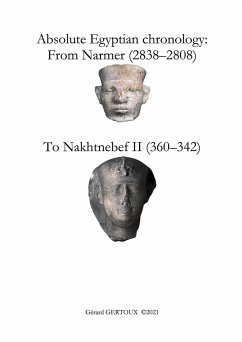Egyptian king lists make it possible to elaborate a chronology of all kings up to Narmer (2838-2808), because the numerous synchronisms between Egyptian and Mesopotamian reigns make it possible to anchor the 30 dynasties of this Egyptian chronology. These synchronisms with the Achaemenid and Babylonian chronologies, which are anchored on absolute dates obtained by astronomy over the period 2243-340 BCE, allow to anchor the Egyptian chronology and to note that the Egyptian lunar calendar began at the full moon and not at the first invisibility as believed by Richard A. Parker in 1950. The Egyptian lunar calendar, based on a 25-year cycle with 9 intercalary years, was used before the 11th Dynasty to date important events according to the number of censuses, not according to the number of reign years. These censuses were carried out during the non-intercalary years, which implies a ratio of 1.6 (instead of 2) between the number of reign years and the number of censuses. Astronomical events, such as eclipses or the rising of Sirius, dated in their civil (365 days) or religious (lunar) calendar, can be retro-calculated by astronomy, allowing the reconstruction of an absolute chronology up to King Djer (2788-2752). The comparison of dates obtained by carbon 14 shows a growing gap from 2200 BCE, and exponentially, with the absolute dates obtained by astronomy. Consequently, the Urukean expansion that took place around 2950 BCE in Sumer is at the origin of predynastic Egypt at Abydos (Dynasty 0). In annex: Comparison of absolute dates and carbon-14 dates; Comparison of absolute dates and biblical dates.
Hinweis: Dieser Artikel kann nur an eine deutsche Lieferadresse ausgeliefert werden.
Hinweis: Dieser Artikel kann nur an eine deutsche Lieferadresse ausgeliefert werden.








